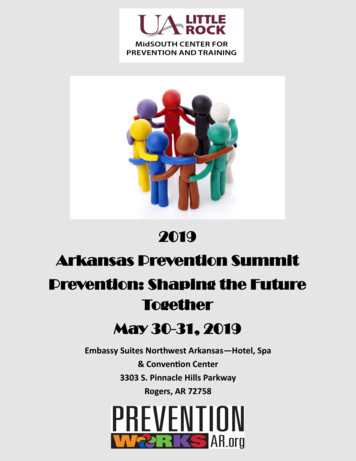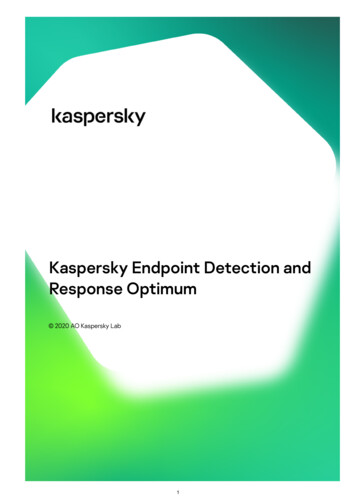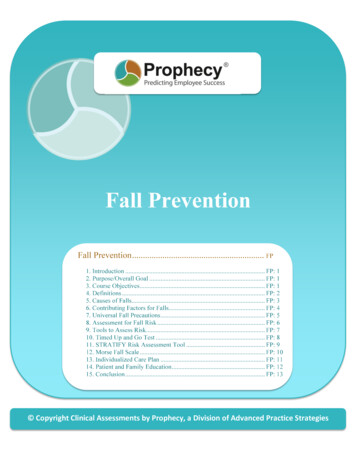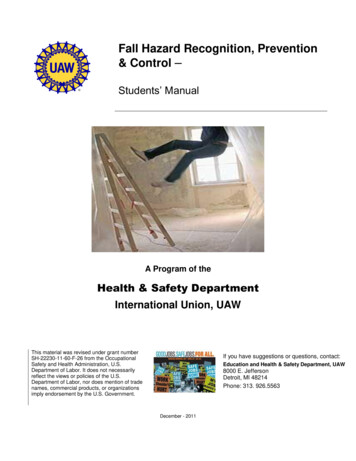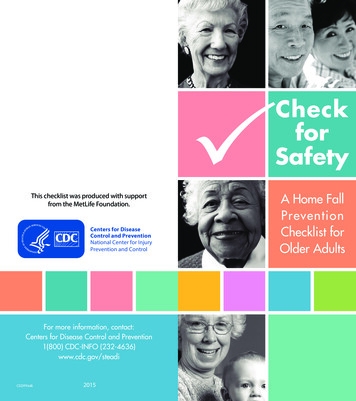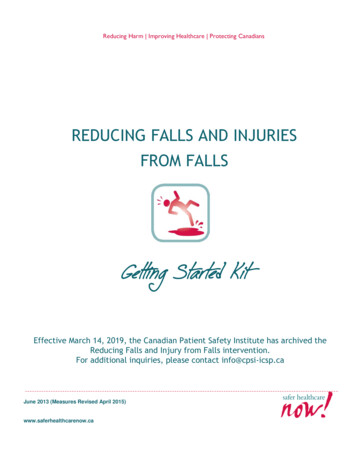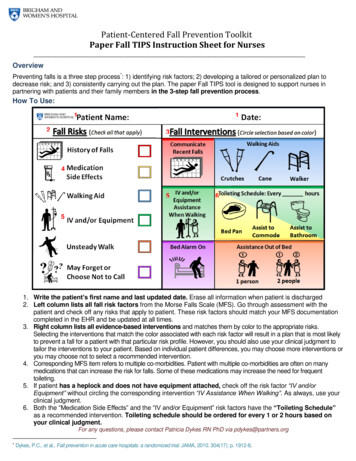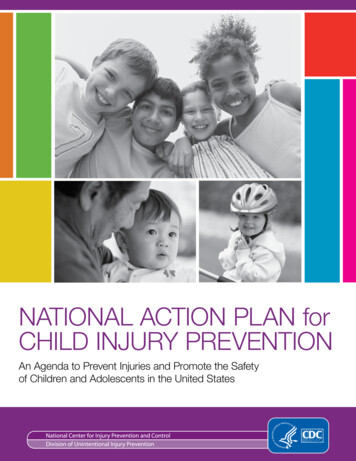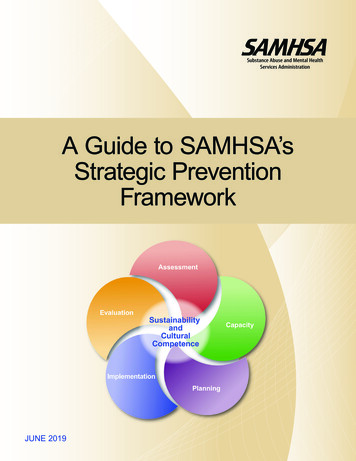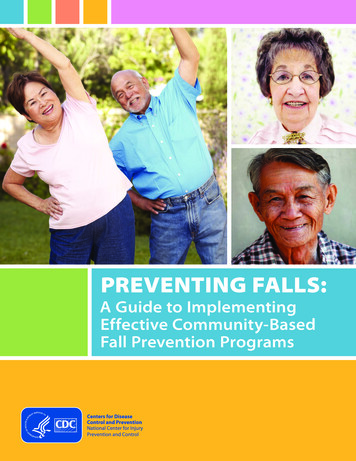
Transcription
PREVENTING FALLS:A Guide to ImplementingEffective Community-BasedFall Prevention Programs
Preventing Falls:A Guide to Implementing EffectiveCommunity-Based Fall Prevention Programs2nd EditionDivision of Unintentional Injury PreventionNational Center for Injury Prevention and ControlCenters for Disease Control and PreventionAtlanta, Georgia2015
This document is a publication of theNational Center for Injury Prevention and Controlof the Centers for Disease Control and Prevention:Centers for Disease Control and PreventionThomas R. Frieden, MD, MPH, DirectorNational Center for Injury Prevention and ControlDebra Houry, MD, MPH, DirectorDivision of Unintentional Injury PreventionGrant Baldwin, PhD, MPH, DirectorHome, Recreation, and Transportation BranchAnn Dellinger, PhD, MPH, Branch ChiefHome and Recreation Injury Prevention TeamRobin Lee, PhD, MPH, Team LeadACKNOWLE DG E M E NTSCDC would like to acknowledge the contributions of the Administration for Community Living(ACL) and U.S. Department of Housing and Urban Development (HUD) for their continuedexpertise and guidance on the development of this guide. The partnership between CDC, ACL,and HUD is critical for advancing the use and uptake of effective fall prevention programs thatcan help safeguard the health of older Americans.Suggested Citation: National Center for Injury Prevention and Control. Preventing Falls:A Guide to Implementing Effective Community-based Fall Prevention Programs. 2nd ed.Atlanta, GA: Centers for Disease Control and Prevention, 2015.Disclaimer: Reference herein to any specific commercial products, programs, or services by trade name, trademark, manufacturer, or otherwise,does not necessarily constitute or imply its endorsement, recommendation, or favoring by the United States Government. The views andopinions of authors expressed herein do not necessarily state or reflect those of the United States Government, and shall not be used foradvertising or product endorsement purposes.iv
CONTENTSChapter 1. Introduction . . . . . . . . . . . . . . . . . . . . . . . . . . . . . . . . . . . . 1Why fall prevention is important . . . . . . . . . . . . . . . . . . . . . . . . . . . . . . . . . . . . 2Understanding fall risk factors . . . . . . . . . . . . . . . . . . . . . . . . . . . . . . . . . . . . . 3Effective interventions can prevent older adult falls . . . . . . . . . . . . . . . . . . . . . . . . 4Purpose of this guide . . . . . . . . . . . . . . . . . . . . . . . . . . . . . . . . . . . . . . . . . . . 4Chapter 2. Planning for a Fall Prevention Program . . . . . . . . . . . . . . . . . . . 7Determine your community’s needs . . . . . . . . . . . . . . . . . . . . . . . . . . . . . . . . . 7Identify resources . . . . . . . . . . . . . . . . . . . . . . . . . . . . . . . . . . . . . . . . . . . . . 8Determine your organization’s readiness . . . . . . . . . . . . . . . . . . . . . . . . . . . . . . . 8Selected web resources . . . . . . . . . . . . . . . . . . . . . . . . . . . . . . . . . . . . . . . . . 9Chapter 3. The Important Role of Partnerships . . . . . . . . . . . . . . . . . . . . . 11Developing partnerships . . . . . . . . . . . . . . . . . . . . . . . . . . . . . . . . . . . . . . . .Maintaining partnerships . . . . . . . . . . . . . . . . . . . . . . . . . . . . . . . . . . . . . . .Building an infrastructure . . . . . . . . . . . . . . . . . . . . . . . . . . . . . . . . . . . . . . .Budget adequate resources . . . . . . . . . . . . . . . . . . . . . . . . . . . . . . . . . . . . . .Selected web resources for developing partnerships . . . . . . . . . . . . . . . . . . . . . . .1112131314Chapter 4. Selecting an Evidence-Based Fall Prevention Program . . . . . . . . . 15What is an evidence-based program? . . . . . . . . . . . . . . . . . . . . . . . . . . . . . . . .Community fall prevention programs . . . . . . . . . . . . . . . . . . . . . . . . . . . . . . . .Selecting a program . . . . . . . . . . . . . . . . . . . . . . . . . . . . . . . . . . . . . . . . . .Program characteristics . . . . . . . . . . . . . . . . . . . . . . . . . . . . . . . . . . . . . . . .Selected program web resources . . . . . . . . . . . . . . . . . . . . . . . . . . . . . . . . . .1515161718Chapter 5. Raising Awareness about Your Program . . . . . . . . . . . . . . . . . . 19Reaching your intended audience . . . . . . . . . . . . . . . . . . . . . . . . . . . . . . . . . .Increasing public awareness . . . . . . . . . . . . . . . . . . . . . . . . . . . . . . . . . . . . . .Developing a plan . . . . . . . . . . . . . . . . . . . . . . . . . . . . . . . . . . . . . . . . . . . .Provider education . . . . . . . . . . . . . . . . . . . . . . . . . . . . . . . . . . . . . . . . . . .Public education . . . . . . . . . . . . . . . . . . . . . . . . . . . . . . . . . . . . . . . . . . . . .Selected fall prevention education web resources . . . . . . . . . . . . . . . . . . . . . . . .191920202122Chapter 6. Implementing Your Fall Prevention Program . . . . . . . . . . . . . . . 23Identify your target audience . . . . . . . . . . . . . . . . . . . . . . . . . . . . . . . . . . . . .Think collaboratively . . . . . . . . . . . . . . . . . . . . . . . . . . . . . . . . . . . . . . . . . .Recruiting program participants . . . . . . . . . . . . . . . . . . . . . . . . . . . . . . . . . . .Assuring program quality . . . . . . . . . . . . . . . . . . . . . . . . . . . . . . . . . . . . . . .23242627v
Appendix E — Template for Developing a Sustainability PlanA GUIDE TO IMPLEMENTING EFFECTIVE COMMUNITY-BASED FALL PREVENTION PROGRAMSProgram fidelity . . . . . . . . . . . . . . . . . . . . . . . . . . . . . . . . . . . . . . . . . . . . . 27Continuous quality improvement (CQI) . . . . . . . . . . . . . . . . . . . . . . . . . . . . . . . 29Selected implementation web resources . . . . . . . . . . . . . . . . . . . . . . . . . . . . . . 29Chapter 7. Evaluating Your Fall Prevention Program . . . . . . . . . . . . . . . . . 31Introduction . . . . . . . . . . . . . . . . . . . . . . . . . . . . . . . . . . . . . . . . . . . . . . .Why evaluate? . . . . . . . . . . . . . . . . . . . . . . . . . . . . . . . . . . . . . . . . . . . . . .Measuring program effectiveness . . . . . . . . . . . . . . . . . . . . . . . . . . . . . . . . . .Goals . . . . . . . . . . . . . . . . . . . . . . . . . . . . . . . . . . . . . . . . . . . . . . . . . . . .Evaluation methods . . . . . . . . . . . . . . . . . . . . . . . . . . . . . . . . . . . . . . . . . . .Types of data . . . . . . . . . . . . . . . . . . . . . . . . . . . . . . . . . . . . . . . . . . . . . . .Types of evaluation . . . . . . . . . . . . . . . . . . . . . . . . . . . . . . . . . . . . . . . . . . .Determining which method to use . . . . . . . . . . . . . . . . . . . . . . . . . . . . . . . . . .Selected evaluation web resources . . . . . . . . . . . . . . . . . . . . . . . . . . . . . . . . . .313232333334353637Chapter 8. Promoting Your Fall Prevention Program . . . . . . . . . . . . . . . . . 39Conducting a successful campaign . . . . . . . . . . . . . . . . . . . . . . . . . . . . . . . . . . 39Working with the media . . . . . . . . . . . . . . . . . . . . . . . . . . . . . . . . . . . . . . . . 41Selected promotional web resources . . . . . . . . . . . . . . . . . . . . . . . . . . . . . . . . 42Chapter 9. Sustaining Your Fall Prevention Program . . . . . . . . . . . . . . . . . 43Establish your vision . . . . . . . . . . . . . . . . . . . . . . . . . . . . . . . . . . . . . . . . . .Build collaborations . . . . . . . . . . . . . . . . . . . . . . . . . . . . . . . . . . . . . . . . . . .Secure funding . . . . . . . . . . . . . . . . . . . . . . . . . . . . . . . . . . . . . . . . . . . . . .Demonstrate benefits . . . . . . . . . . . . . . . . . . . . . . . . . . . . . . . . . . . . . . . . .Delivery infrastructure . . . . . . . . . . . . . . . . . . . . . . . . . . . . . . . . . . . . . . . . .Strategies for achieving financial sustainability . . . . . . . . . . . . . . . . . . . . . . . . . .Selected sustainability web resources . . . . . . . . . . . . . . . . . . . . . . . . . . . . . . . .43444445454547Appendices . . . . . . . . . . . . . . . . . . . . . . . . . . . . . . . . . . . . . . . . . . 49Appendix A — Stay Independent brochure . . . . . . . . . . . . . . . . . . . . . . . . . . . .Appendix B — Educational Materials for Older Adults . . . . . . . . . . . . . . . . . . . . . .What YOU Can Do to Prevent Falls — A fall prevention brochure . . . . . . . . . . . . . . .Check for Safety — A home safety checklist . . . . . . . . . . . . . . . . . . . . . . . . . . .Exercise & Physical Activity Book . . . . . . . . . . . . . . . . . . . . . . . . . . . . . . . . . .Appendix C — Sample Letter to a Health Care Provider for Referrals . . . . . . . . . . . . .Appendix D — Program Evaluation Checklist . . . . . . . . . . . . . . . . . . . . . . . . . . .Appendix E — Template for Developing a Sustainability Plan . . . . . . . . . . . . . . . . .vi4950505051525356
Chapter 1. IntroductionCHAPTER 1IntroductionFalls are the leading cause of fatal and nonfatal injuriesamong adults 65 and older and 10,000 people in the UnitedStates turn 65 every day. Community-based organizations(CBOs) play an important role in promoting the health andwell-being of the residents in their community. Many ofthe services provided by CBOs like yours help people of allages maintain healthy lifestyles and improve their qualityof life. This includes expanding efforts to reduce falls amongolder adults.CBOs who want to prevent falls recognize that they mustoffer effective evidence-based fall prevention programs.However, choosing a fall prevention program that isappropriate for clients, readily available with training andtools in place, and affordable can be a daunting task.The purpose of this guide is to provide information to helpCBOs choose and implement evidence-based fall preventionprograms based on their organization’s goals and clients’needs. It also describes the organizational resources andpartners needed to support and sustain the program.This guide addresses questions that are important to CBOswhen implementing fall prevention programs such as: How do we find a fall prevention program that best meetsthe needs of our clients? How can we know that this program works and will achievethe desired results? What resources will be needed to support it? What partners should we consider to help us offerthe program? How can we support and sustain the program intothe future?1
Appendix E — Template for Developing a Sustainability PlanA GUIDE TO IMPLEMENTING EFFECTIVE COMMUNITY-BASED FALL PREVENTION PROGRAMSThis revision of the 2008 publication,Preventing Falls: How to Develop Communitybased Fall Prevention Programs for OlderAdults, will improve your organization’sability to reach out to the older membersof your community as well as enhanceyour capacity to implement and maintaineffective fall prevention programs.Please note: The interventions andprograms discussed in this guide are notdesigned for hospital patients, assistedliving or nursing home residents, orpatients with dementia or Alzheimer’sdisease. These persons require programsand interventions that are specificallydesigned for their increased frailtyand fall risk.Why fall preventionis importantFalls are a major threat to the health andindependence of older adults. Each year,one in three older adults aged 65 and olderexperiences a fall, and people who fallonce are two to three times more likelyto fall again.Falls can be devastating. Falls arethe leading cause of nonfatal injuriesamong older adults. One out of ten fallscauses a serious injury, such as a hipfracture or head injury, which requireshospitalization. In addition to the physicaland emotional pain, many people needto spend at least a year recovering in along-term care facility. Some are neverable to live independently again.2Falls can be deadly. Among older adults,falls are the leading cause of fatal injuries.Each year, at least 25,000 older adults dieas a result of falls. And the rate of fallrelated deaths among older adults in theUnited States has been rising steadily overthe past decade.Falls are preventable. People are livinglonger and falls will increase unless wemake a serious commitment to providingeffective fall prevention programs.Fortunately, the opportunity to helpreduce falls among older adults hasnever been better, because research hasdemonstrated that falls can be prevented.Today, there are effective fall preventionprograms that can be used in communitysettings. By offering these programs inour communities, we can reduce falls andhelp older adults maintain their health andindependence.
IntroductionUnderstanding fallrisk factorsFalls are not an inevitable consequenceof aging. However, falls do occur moreoften among older adults because fall riskfactors increase with age. A fall risk factoris something that increases a person’schances of falling. This may be a biologicalcharacteristic, a behavior, or an aspect of theenvironment. These risk factors include:Biological risk factors––Muscle weakness or balance problems––Medication side effects and/orinteractionsHome or environmental risk factors play a rolein about half of all falls (Bergen et al., 2008).––Chronic health conditions such asarthritis and strokeUnderstanding these risk factors is the firststep to reducing older adult falls. Over thepast two decades, researchers around theworld have identified fall risk factors and usedrandomized controlled trials (RCT), to test fallinterventions. RCTs are considered the “goldstandard” for evaluating an intervention’seffectiveness. The results of these studiesshow that reducing fall risk factorssignificantly reduces falls among communitydwelling older adults—that is, people livingindependently in the community.––Vision changes and vision loss––Loss of sensation in feetBehavioral risk factors––Inactivity––Risky behaviors such as standing on achair in place of a step stool––Alcohol useEnvironmental risk factors––Clutter and tripping hazards––Poor lighting––Lack of stair railings––Lack of grab bars inside and outsidethe tub or shower––Poorly designed public spacesUsually two or more risk factors interact tocause a fall (such as poor balance and lowvision) (Rubenstein and Josephson 2006). Themore risk factors a person has, the greatertheir chances of falling (Tinetti et al., 1986).Many older adults, as well as their familymembers and caregivers, are unaware offactors or behaviors that put them at risk offalling. They are also unaware of actions theycan take to reduce their risk. Fall risk factorassessment is rarely part of an older adult’sroutine health care, even if they have had afall or fall injury. All older adults should beencouraged to seek an individual fall riskassessment from their health care providers,especially older adults with a history of fallsand/or with mobility or balance problems3
Appendix E — Template for Developing a Sustainability PlanA GUIDE TO IMPLEMENTING EFFECTIVE COMMUNITY-BASED FALL PREVENTION PROGRAMSEffective interventions canprevent older adult fallsCDC has identified community-based fallprevention interventions that have strongscientific evidence of effectiveness. Allwere found to be effective in randomizedcontrolled trials. These interventions havebeen summarized and compiled in A CDCCompendium of Effective Fall Interventions:What Works for Community-Dwelling OlderAdults, the companion publication to thisdocument. CDC would like to help CBOstranslate and implement these proven fallinterventions.The CDC Compendium is available at:www.cdc.gov/STEADI.who are at highest risk for falls. A fallrisk assessment is covered in the annualMedicare Wellness Visit.To help older adults better understand theirfall risk, the Centers for Disease Control andPrevention’s (CDC) Injury Center helpeddevelop the Stay Independent brochure.This is a validated fall risk self-assessmenttool that can be used in clinical orcommunity settings to raise awarenessabout fall risks as well as help older adultsbegin to discuss this sensitive topic withtheir health care providers.The Stay Independent brochure is shown inAppendix A and is available at:www.cdc.gov/STEADI.The Administration for Community Living’sAdministration on Aging has also identifiedevidence-based community programs thatreduce falls or falls risks. A list of theseprograms is available at: www.ncoa.orgPurpose of this guideCDC developed this guide to helpcommunities and CBOs identify appropriateevidence-based fall prevention programsthat can be implemented in the community.It also describes the resources needed toimplement and sustain these fall preventionprograms.The main purposes of this guide are to: Promote an integrated, collaborativeapproach to fall prevention Provide guidelines for selecting anappropriate fall prevention program4
Introduction Provide strategies for developingpartnerships Provide information on building theinfrastructure needed to implementeffective programs Suggest approaches to improvingprogram implementation Provide methods for evaluating programs Suggest ways to promote programs Provide resources and strategies toincrease sustainabilityThis guide is intended for CBO decisionmakers, program managers and partners inorganizations that serve older adults livingindependently in the community such as: Area Agencies on Aging Emergency medical services Faith-based and parish nurse servicesand programs Health care organizations that provide Public health departments Senior and community centers State Medicaid agencies Universities and/or community collegesthat offer programs for older adults livingin the community.ReferencesBergen G, Chen LH, Warner M, Fingerhut LA.Injury in the United States: 2007 Chartbook.Hyattsville: National Center for HealthStatistics, 2008.Rubenstein, L.Z. & Josephson, K.R. (2006).Falls and their prevention in elderly people:what does the evidence show? Med ClinNorth Am, 90(5), 807–824.Tinetti, M.E., Williams, T.F. & Mayewski, R.(1986). Fall risk index for elderly patientsbased on number of chronic disabilities.Am J Med, 80, 429–434.individual health care, individual orgroup community programs, andhome-based services Home-based services (e.g., home health,meal-delivery services, chore services) Hospital outpatient and communityprograms Independent/retirement living, residential,and senior housing facilities and/or settings for older adults who liveindependently Nonprofit organizations that providedirect services to older adults Parks and recreation organizations5
Chapter 2. Planning for a Fall Prevention ProgramCHAPTER 2Planning for a FallPrevention ProgramFollow these important steps when planning yourfall prevention program.Determine your community’s needsBefore deciding what fall prevention program to implement,answer the following questions to determine yourcommunity’s needs and identify appropriate resources. What information or data do you have about the burdenof falls in your community? (Sources may includecommunity hospitals, emergency medical services, andlocal and/or state public health departments.) How much support for starting a fall preventionprogram is there at all levels of your organization—from the board and director, to the staff, volunteers,and older adult clients? What are your organization’s current and future goalsand resources for providing services to older adultsin your community? What related programs or services are currently beingoffered by your or other organizations in your area? What existing community resources could provideservices to address or support older adult fallprevention programs? What organizations or community champions wouldjoin in planning to implement this program?7
Appendix E — Template for Developing a Sustainability PlanA GUIDE TO IMPLEMENTING EFFECTIVE COMMUNITY-BASED FALL PREVENTION PROGRAMSIdentify resourcesThere may be community resources andprograms already in place that can helpsupport your fall prevention efforts. The Kansas University Community Toolboxoffers strategies for identifying resources.The chapter, Assessing Community Needsand Resources, offers strategies to helpusers organize their approach. It isavailable at: ctb.ku.edu/en Additional resources can found in APractical Guide to State Coalition Building toAddress a Growing Public Health Issue.It is available at: www.ncoa.orgDetermine yourorganization’s readinessDetermine your organization’s readiness toimplement an evidence-based fall preventionprogram by addressing these key questions: Is there buy-in from leadership? Is initial funding available to implementthe program? Is our agency/partnership committed toimplementing an evidence-based programwith fidelity? Are trained personnel available to offerthe program? Do we know how we’ll sustain theprogram going forward by embedding itinto existing operations? Have we thought through potential longterm financing strategies including publicand private funding? Can we leverage existing models fordelivering a fall prevention program?8
Planning for a Fall Prevention ProgramHawaii’s Fall Prevention ConsortiumTo elevate fall prevention as a priority issue,the Hawaii Department of Health establisheda Fall Prevention Consortium consisting ofgroups interested in aging issues. Membersincluded key stakeholders from health andsocial service organizations, state and countyagencies, and academic institutions.Using the Hawaii Injury Prevention Plan 2012–2017 as a guide, the Consortium developed anaction plan for reducing older adult falls. Theplan’s primary strategies included 1) raisingawareness about fall prevention amongolder adults, 2) increasing the availabilityof fall prevention services, and 3) engagingprofessional and community members infall prevention activities. The Consortium iscurrently working with member organizationsto implement and evaluate this action plan.Selected web resourcesFalls Free: A National Falls Prevention Action PlanHawai’i Injury Prevention Plan files/2013/09/Hawaii Injury PreventionPlan 2012 to 2017 4mb.pdfOverview of the Falls Injury Prevention Programin Queensland, ments/overview.pdfWashington State Dept. of Health Report—Falls Among Older Adults: Strategiesfor FallsAmongOlderAdults.pdfAdapted from the Core VIPP (2011–2016) FallsPrevention Activities fact sheet9
Chapter 3. The Important Role of PartnershipsCHAPTER 3The Important Roleof PartnershipsIt may be difficult for your organization, on its own, toimplement a fall prevention program. By collaboratingwith other community organizations and professionals thatspecialize in different types of services for older adults,such as health care, exercise, home safety assessments,and education, you can make your program morecomprehensive, effective, and possibly less costly. Forexample, a public health or health care organization maypartner with a senior services or parks and recreationorganization to offer a Tai Chi program.Collaborating with other CBOs can provide additionalresources, outreach channels, or referral sources for yourprogram. Because of its many benefits, collaboration canbe essential to implementing your program and sustainingit over time.Developing partnershipsAssess your current situation. Planning your fallprevention program involves a careful analysis of yourorganization’s resources and needs, including staff,funding, facilities, technology, and expertise. Thisinformation clarifies when a potential partnership withanother organization can support your program goals.Identify potential partners. Partnerships should bemutually beneficial. Identify organizations that share yourmission of improving health and safety for older adults orthat have a vested interest in reducing falls among olderadults. Determine how collaboration will support short- andlong-term goals.11
Appendix E — Template for Developing a Sustainability PlanA GUIDE TO IMPLEMENTING EFFECTIVE COMMUNITY-BASED FALL PREVENTION PROGRAMSDevelop your “pitch” for partnership.After strategically selecting potentialpartners, develop your “pitch,” or sellingpoints, for partnership. These will vary basedon the resources, needs, and priorities ofeach organization. Showcase the benefitsfor your potential partners.Create your messages and materials.Develop message points—short, concisestatements that reflect your main messages.These are useful for internal and externalcommunications as well as for presentationsto partners.For these messages: Develop themes or adapt materials thatwill engage your potential partners. Produce materials (presentations,flyers, etc.) that will effectively conveyyour messages. Pretest your materials among potentialpartners. Develop a method for trackingpartnerships and other outreach efforts.Make contact. Whenever possible, deliveryour partnership proposal in person.Consider bringing at least one other person,because different communication styles anddispositions can influence an encounter.Sharing the workload and presentationdelivery reduces the pressure of thinkingon your feet. However, prepare carefully inadvance to make sure that your team speakswith one voice based on the messages youdevelop. Delivering mixed messages createsconfusion and weakens your credibility.Seal the deal. Being credible and offeringincentives are important but these may notbe enough to seal the deal. Use your passion12to make potential partners recognize theyshould be involved. Describe how your programs and servicescan make a difference. Share information about the burden offalls and fall injuries. Underscore how your community willbenefit from your efforts and how othersare getting involved.Maintaining partnershipsRelationships need to be maintained.While commitment is important, so iscontinuing to review your resources, needs,and expectations as the program evolves.Involving local organizations will be anongoing effort, so remember to engageas many facets of your community as youcan, including: Hospitals and health care organizations Local and state government officialsand offices Faith-based organizations Civic organizations Senior citizen groups Commercial establishments servingolder adults Clubs that may have a large older adultmembership (such as the Veterans ofForeign Wars) Universities or colleges that offeracademic programs or services forolder adultsIt is important to remind potential partnersof their strengths and how even seeminglysmall contributions can help prevent injuryand death. Confirm how the proposed
The Important Role of Partnershipspartnership will be mutually beneficial, bespecific about what you are asking them tocontribute and do.Never forget the power of the phrase “thankyou.” Acknowledge partnership agreementspromptly. Look for creative ways to conveyyour gratitude to partners often and thankthem publicly.Building an infrastructureDevelop relationships with keyorganizations in your area to create robustcommunication channels. Reach out togovernment, nonprofit, religious andother leaders who can help you reach theirconstituents or members.Create a database of prospects: Enter the name and contact informationof each person who calls or looks forinformation about a program. Keep building this list and sendingmessages, either by e-mail, phone, or mail.Develop a list of key media outlets in yourarea—TV, radio, and newspapers, as wellas social media,—especially those that arepopular with your target audience.Budget adequ
Home or environmental risk factors play a role in about half of all falls (Bergen et al., 2008). Understanding these risk factors is the first step to reducing older adult falls. Over the . past two decades, researchers ar



